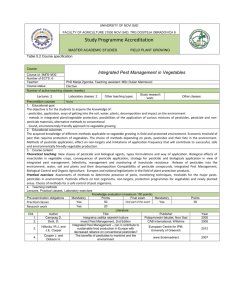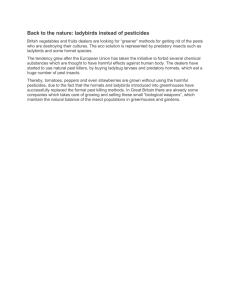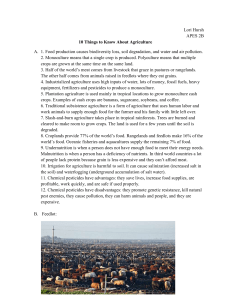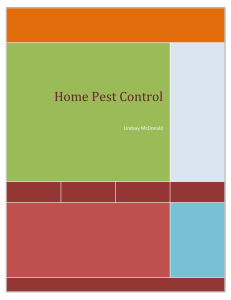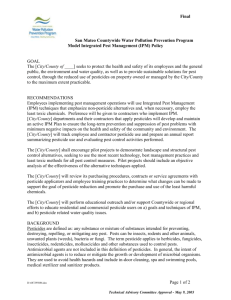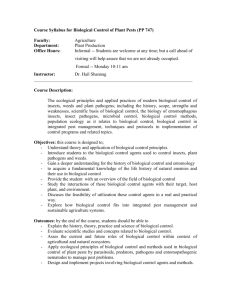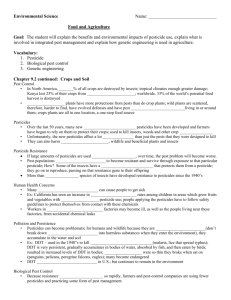Environmental Science Name: Food and Agriculture Goal: The
advertisement
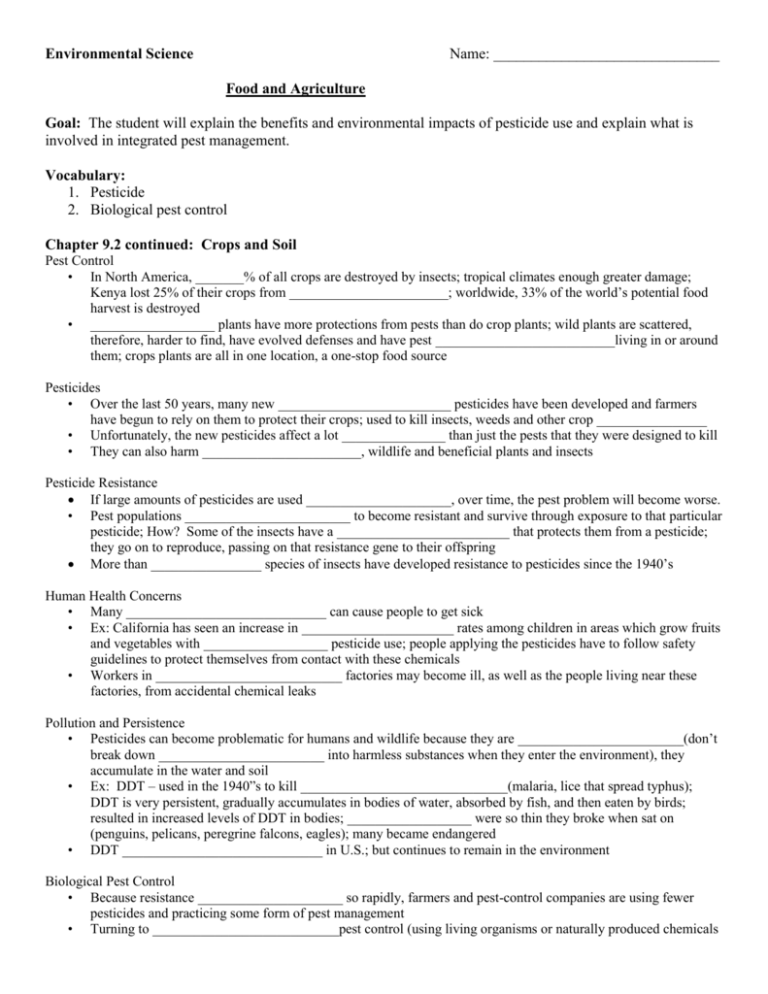
Environmental Science Name: ______________________________ Food and Agriculture Goal: The student will explain the benefits and environmental impacts of pesticide use and explain what is involved in integrated pest management. Vocabulary: 1. Pesticide 2. Biological pest control Chapter 9.2 continued: Crops and Soil Pest Control • In North America, _______% of all crops are destroyed by insects; tropical climates enough greater damage; Kenya lost 25% of their crops from _______________________; worldwide, 33% of the world’s potential food harvest is destroyed • __________________ plants have more protections from pests than do crop plants; wild plants are scattered, therefore, harder to find, have evolved defenses and have pest __________________________living in or around them; crops plants are all in one location, a one-stop food source Pesticides • Over the last 50 years, many new _________________________ pesticides have been developed and farmers have begun to rely on them to protect their crops; used to kill insects, weeds and other crop ________________ • Unfortunately, the new pesticides affect a lot _______________ than just the pests that they were designed to kill • They can also harm _______________________, wildlife and beneficial plants and insects Pesticide Resistance If large amounts of pesticides are used _____________________, over time, the pest problem will become worse. • Pest populations ________________________ to become resistant and survive through exposure to that particular pesticide; How? Some of the insects have a _________________________ that protects them from a pesticide; they go on to reproduce, passing on that resistance gene to their offspring More than ________________ species of insects have developed resistance to pesticides since the 1940’s Human Health Concerns • Many _____________________________ can cause people to get sick • Ex: California has seen an increase in ______________________ rates among children in areas which grow fruits and vegetables with __________________ pesticide use; people applying the pesticides have to follow safety guidelines to protect themselves from contact with these chemicals • Workers in ___________________________ factories may become ill, as well as the people living near these factories, from accidental chemical leaks Pollution and Persistence • Pesticides can become problematic for humans and wildlife because they are ________________________(don’t break down ________________________ into harmless substances when they enter the environment), they accumulate in the water and soil • Ex: DDT – used in the 1940”s to kill ______________________________(malaria, lice that spread typhus); DDT is very persistent, gradually accumulates in bodies of water, absorbed by fish, and then eaten by birds; resulted in increased levels of DDT in bodies; __________________ were so thin they broke when sat on (penguins, pelicans, peregrine falcons, eagles); many became endangered • DDT _____________________________ in U.S.; but continues to remain in the environment Biological Pest Control • Because resistance _____________________ so rapidly, farmers and pest-control companies are using fewer pesticides and practicing some form of pest management • Turning to ___________________________pest control (using living organisms or naturally produced chemicals • to control pests); every pests has enemies in the wild and those enemies can be used to __________________ pest populations (ex: In India (mid-1800’s), American prickly pear cactus had been introduced into India to feed insects that are used to make a valuable ______________dye; Cactus had no natural enemies, grew and spread. Plants were finally controlled by the introduction of an American beetle that eats cactus Generally, do no ____________________anything but the particular pest it is designed to control, resistance takes longer to evolve Pathogens • Releasing a natural ________________________ or parasite is one method of biological control • _________________________ (organisms causing disease) is another method • Ex: Bacillus thuringensis (bacterium) kills larvae (caterpillars of moths and butterflies) Lesson Reflection: Compare the benefits and environmental impact of pesticide use. Assessment: 1. Define the term pest. 2. Describe how biological pest control is part of integrated pest management. Active Reading: Crops and Soil Lesson Extension (Technology/Application/Connection to Real World): Learn 360 – The Exterminator (45 min)

